AN10907
All information provided in this document is subject to legal disclaimers.
© NXP B.V. 2010. All rights reserved.
Application note
Rev. 1 — 28 December 2010
6 of 82
NXP Semiconductors
AN10907
TEA1613T resonant power supply control IC
3. Pin overview with functional description
Table 1.
Pinning overview
Pin
Name
Functional description
1
SNSOUT/PFCON
Input for sensing (indirectly) the output voltage of resonant converter. Normally connected to an
auxiliary winding of HBC.
Also output signal for PFC to hold switching in order to provide synchronous burst mode
operation.
This pin has 2 functions related to internal comparators:
•
Overvoltage protection: SNSOUT >3.5 V, latched
•
Undervoltage protection: SNSOUT <2.3 V, protection timer
The pin also contains an internal current source of 100 mA that, initially, generates a voltage up
to 1.5 V across an external impedance (>20 k
recommended). This voltage level should
enable PFC operation (PFCON). After start-up this level is higher, representing the state of the
output voltage.
During burst mode, an internal switch makes this voltage level low during the time that the HBC
is not switching.
2
SNSFB
Sense input for HBC output regulation feedback by voltage.
Sinking a current from SNSFB provides the feedback-voltage on SNSFB. This current through
an internal resistor (1.5 k
), internally connected to 8.4 V results in the regulation voltage.
The regulation voltage range is from 4.1 V to 6.4 V, and corresponds with the maximum and
minimum frequency that can be controlled by SNSFB. The SNSFB range is limited to 65 % of
the maximum frequency preset by RFMAX.
Open loop detection is provided, activating the protection timer when SNSFB is (remains) above
7.7 V.
3
SNSBURST
Sense input for regulation voltage to enter burst mode.
Externally connected to SNSFB by using a resistive divider.
When the voltage on SNSBURST drops below V
burst(SNSBURST)
= 3.5 V, the HBC pauses its
operation. When the voltage on SNSBURST increases to above V
burst(SNSBURST)
+ internal
hysteresis = 3.6 V it resumes operation without a soft-start sequence. The transition level can
be chosen by the values of the resistors used.
An internal current source compensates the transition level for variations on boost voltage
(supply voltage of the converter) by using the SNSBOOST information. The total impedance of
the resistive divider determines the amount of compensation.
4
SNSBOOST
Sense input for boost voltage.
Externally connected to resistor divided boost voltage.
As soon as the voltage on this pin drops below V
UVP(SNSBOOST)
= 1.6 V, switching of the HBC is
stopped at the moment the low-side MOSFET is on.
An internal hysteresis current source of 3 mA in combination with the resistance of the external
divider determines the start level. The boost voltage for starting is higher than the boost voltage
for stopping.


















